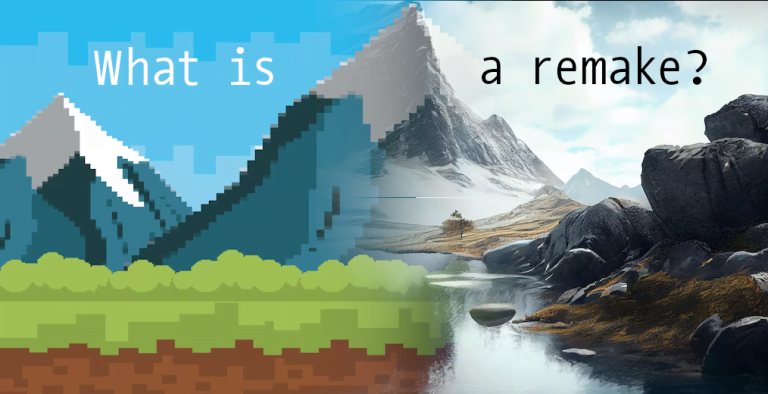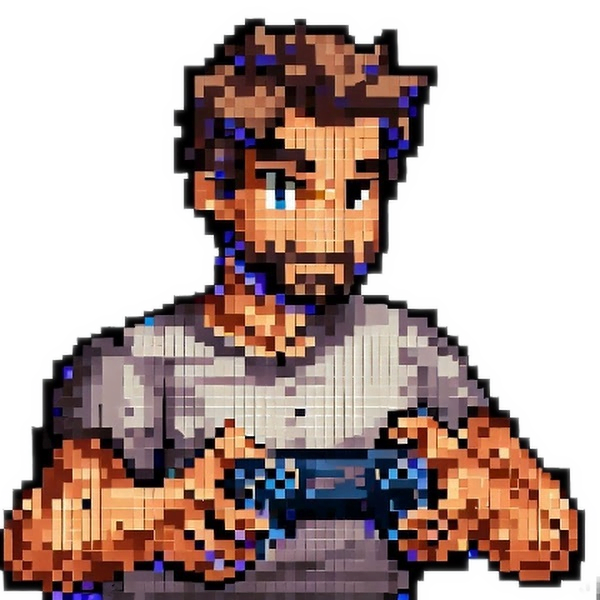What Makes a (Good) Video Game Remake? 5 Criteria

As developers continue to blur the line between remakes, remasters, reboots, and other ports, we can often end up being disappointed. What is considered to be a proper remake on RetroToHero.com? And what should a good video game remake try to achieve? Here are 5 criteria to consider.
Table of Contents
Toggle#1: Enough time & Legacy
I’ll start with perhaps the most controversial one, but one of the major criteria of what constitutes a remake should be how much time has passed since the original was first released.
A game that hasn’t established a legacy, and doesn’t undergo a significant generational gap in terms of hardware and players, cannot be remade. It can merely be fixed, updated, or upgraded. A game presented as a “remake” that is only released within just a few years from the original is likely to be more of a remaster, or a “patch”: better graphics, a few tweaks to the gameplay that mostly consist of “corrections”, and perhaps some additional material akin more to DLCs than a do-over. In an age when games tend to be systematically “patched” and expanded on over the first few months following their release, a proper do-over should be more than that.
This explains why the Final Fantasy XIV we know today could never possibly be considered a remake. Yet it is nothing like its first version, released in 2010. After a catastrophic launch, criticized for many bugs, a convoluted UX, and a lack of content, Square Enix made a smart choice: while they decided to acknowledge its failure and start over, they presented Final Fantasy XIV: A Realm Reborn, as something between a proper relaunch, and a sequel: the story would follow up on the conclusions of the first version, and carry over the lore already established, but inscribing all the revamped design and gameplay elements in what was packaged as a “new game”.
On the other hand, “The Last of Us: Part 1”, despite being marketed as a “remake”, isn’t one. It is true that the 9-year gap had allowed the initial game to establish a strong legacy. But since the game had already been remastered on PS4, and that the overall gameplay mechanisms, graphics, and experience did not undergo drastic changes because the original still held things pretty well (we still have a third-person view action gameplay, in 3D environments, with decipherable animations and solid voice-acting and narration), there wasn’t much added-value in the remake. Many critics called out how it was more of a new-gen remaster than a proper remake, and regretted the lack of new content, both in terms of story and gameplay.


#2: A dual audience
As a logical follow-up to the previous point, there are two reasons why a remake should be worth it considering for players and developers alike. First, a remake by definition will capitalize on the nostalgia of older gamers who played the original and want to relive, in a new light, a similar experience. Second, it will attract younger players and their modern standards to an established game or franchise without having to imagine a full story and/or concept from scratch.
A remake, in essence, is going to target these two audiences, and its ability to tread carefully on this line will dictate whether we have a good remake, or not. The recent spree of AAA production-value remakes from the industry’s biggest developers is explained through the perfect timing to do so: as of 2022, 40% of gamers in the US are 35 years old and above, and this trend is likely to continue.
As explored in my other articles, the trailers of upcoming remakes such as Silent Hill 2, or Metal Gear Solid Delta: Sneak Eater suggest that Konami aims to bring back the portion of players who were already playing their games in the late 90s and early 2000’s. And its choice to launch slightly before the remake actual remastered versions of the first three Metal Gears Solid suggest that Delta will try to bring something new to both audiences.
Another reason also pertains to localization. Back then, global and multi-console releases were sparse, and led a generation of players to hear about, but miss out on extraordinary games. The choice to remake Live a Live in a fairly conservative fashion (upcoming review soon) is perfectly justifiable given how the original game had never been released outside of Japan.

#3: Re-Designed Experience
With that said, a truly modernized design is crucial to justify a remake. By design I don’t only mean artistic direction, such as character design or the transition from 2D to 3D environments, but also main gameplay mechanisms. Just one of those is generally not enough.
Let’s consider Golden Eye, an all-time N64 classic originally released in 1997, and remade for Wii in 2010. The transition to Wii was of course valuable in terms of gameplay, as it used the motion-capture capabilities of the Wiimote to replace the horrible ergonomics of C-directional buttons on the N64 pad. But that alone wouldn’t have been far from releasing a VR spin-off to recently released games, as was just announced for Resident Evil 4. What Golden Eye Wii did well was also to modernize the entire experience: aligning the scenario and the voice-acting to Daniel Craig’s character – a more fleshed-out, complex version of James Bond than Piers Brosnan’s – and re-creating the environments from scratch to expand on the original game’s foundations.
The same could be said of the first three Resident Evils, initially released on PlayStation throughout the ’90s, and remade respectively on Gamecube (2002) and PS4, Xbox One & Windows in the late 2020s. Clunky gameplay, especially controls, were completely modernized, while new environmental layouts, cutscenes, and overall much better graphics greatly contributed to improving, rather than simply re-rendering, the survival-horror atmosphere of their predecessors.
It is all of these factors, put together, that make a proper and good remake. This is where, in my opinion, the 3D remake of Secret of Mana failed. Yes, the game switched from 2D to “3D” (more or less) environments and characters, while also featuring a re-orchestrated soundtrack. But on top of the disputable quality of these transformations, gameplay changes were left to a minimum. On the one hand, the areas in-game were arranged, spatially, exactly like the original, as constantly reminded to us by the on-screen map featuring the Super Nes 2D tiles. On top of that, very archaic mechanisms from the original game were kept as such (inventory ring menu, inconsistent hitbox, poor AI), making this remake, in the end, unnecessary.
Its sequel, Trials of Mana, was more successful in this transformation, not only because it allowed a Western audience to try out Seiken Densetsu 3 for the first time, but also because it implemented smart modifications to the original gameplay.

#4: New story-telling
An essential piece of the identity of many games is their story or narration. Setting, plot, characters’ personalities and backstories, and overarching themes are hard to change significantly without, in the end, imagining a new game, a sequel, or a spin-off.
A proper remake should therefore usually stick as closely as possible to the overall story or universe. With that said, it doesn’t mean it should stick to the same story-telling devices. Story-telling, as its name suggests, is a game’s ability to tell its story in the most immersive, impactful, and memorable way possible. Inserting a flashback at a given point, playing with a non-linear narrative, giving more or less weight to a character or a dialogue at any given point, or stressing a theme more heavily than another will significantly change the interpretation of a given story. While these devices depend a lot on the writers’ choices, it also depends on the technology and resources (time, money) available to developers.
And this is why a good remake should make the most of this opportunity. To retell, instead of to repeat, a story that has already proven its effectiveness. Final Fantasy VII: Remake plays beautifully on the fringes of that distinction: the main narrative progression is the same as the original game, and many characters, settings, and scenes are immediately recognizable to players who had played the original game. But it also presents the same chain of events through new perspectives, new plot points, and lore elements that create the potential for a very different experience from the original.
Those additions are extremely well “told” because they constantly play with an ambiguity that will make all the players intrigued: are we subverting the original story, and will we move increasingly away from it as the next installments are released? Or are we simply giving new light to elements of the original game that couldn’t be shown or acknowledged the first time around? No matter what the outcome will be, some form of coherence with the original game will need to be met, and it will be interesting to see how the second installment of this remake, Final Fantasy VII: Rebirth, will continue – or not – to find such a balance.


#5: Bridging the gaps
Down the line, when putting all of the previous criteria together, what makes a (good) remake?
A remake, unlike a remaster or a port, will re-imagine, re-create, and re-tell an old experience in new and improved ways. Doing so, it will bridge gaps. Not only the gaps or limitations of the original game but also the gap that may exist between different generations of hardware, and players.
To old(er) players like myself, who were lucky to have played the original games, that experience will be filled with nostalgia. It will allow us to dive back into the characters, environments, and emotions that had shaped part of our childhood. But it may also provide us with something that reignites the flame, and emulates the sense of discovery we felt back then: expanded lore, story twists, more engaging gameplay, or breathtaking graphics. Perhaps reconciling some of us with a video game industry we may sometimes perceive as too saturated, and having lost its magic.
To new players, who didn’t have the chance to play the originals, a good remake will provide them with the modern qualities, technical prowess, and production value that they are used to, applied to a story or concept that has passed the test of time. But it may also allow them to catch a glimpse of what, specifically, made certain franchises so important in the history of video games: a particular scene, a musical score, an unforgettable hero, a unique atmosphere, or a beautiful story. And perhaps, along the way, some of them will be tempted to travel back in time and explore these relics.
A good remake will touch all generations of players, creating, hopefully, a (re)discovery that they can share together.
Images credits:
The Last of Us & The Last of Us: Part 1: ©2013, 2022 Sony Interactive Entertainment LLC. Created and developed by Naughty Dog LLC. The Last of Us is a registered trademark of Sony Interactive Entertainment LLC and related companies in the U.S. and other countries.
Secret of Mana: ©2018 Square Enix
Final Fantasy VII: Remake: © 2020 Square Enix
Final Fantasy VII: Rebirth: © 2023 Square Enix, screenshot taken during the Summer Game Gest livestream.
Author
-

I'm a long-time gamer, prof and writer who, between family and professional duties, still tries to keep up with my passion. I'm fascinated by video game remakes (even bad ones), and how they allow older and younger players to dive back into - and reflect on - the history of video games.
You can follow me here, or also @retrotohero on Twitter(X) and Youtube for all sorts of content!
View all posts
